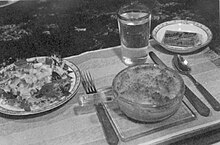Topic name: Mennonite cuisine
Wikipedia:WikiProject_Food_drink

The history of Mennonite food demonstrates tragic world of the past, and food can be represented as hope for the Mennonite. A mix of Mennonite food causes people to be interested in Mennonite culture. Although Mennonite cuisine is not popular worldwide compared with some developed countries or tourism cities, these cuisines which contain the history and wish are unique and specific. Its cookbooks may be only considered as one common book by people, while the Mennonite recipes are faith to push them forward. Once Mennonite cuisine is significantly known by people through the professional resources, its trend may be promoted to the whole world, which can reduce the speed of concentration on Mennonite food.
History
editThis source[1] will be used to describe “the history of Mennonite food”, and “the meaning of Mennonite recipes” sections of Wikipedia page. The concepts of this source benefit description of the survival of Mennonites, and the memory of food or life. According to the experienced women’s description as the typical example, the contents become more authentic. Additionally, this source relies on various authors’ articles, some experienced Mennonites’ autobiography and a large number of reliable books to support its details. The Mennonite food is essential to help Mennonites who experienced famine, starvation, and the war cover up their negative emotion, which is explained in this article. Mennonites' thoughts has the obvious differences from the ordinary people who live in the peaceful years about food, and the custom has also been passed down from generation to generation. All of the details are fully described in this source to increase people’s credibility for this article. At the same time, the contents of this source enhance this article’s reality due to the professional edit.
The meaning of Mennonite cuisine
editThis article[2] not only shows kinds of Mennonite Food, but also it is relevant to the Mennonite’s attitude toward recipes. The source is useful for readers to deeply understand the importance of Mennonite cuisine and will be used in the “The meaning of Mennonite recipes” sections. The authors discuss a part of Katie Doke Sawatzky’s arguments from her stories about the life’s unfair or the judgement, therefore, it leads to people’s deep thoughts about the implication of cuisine or recipes. Moreover, the source combines different evidence from specialists to enrich the meaning of recipes. For instance, recipes are not simply considered the book for cook, but it represents one way to enhance the relationship between Mennonites and are regarded as a major aspect of the covenant. The information of the source strengthens its consistency to prove the reality and neutrality of source, rather than someone’s one side opinions or blogs.
Types of food
editThis article[3] will be used in “Types of Food” sections of Wikipedia page. There are some reasons why the source is chosen. The first one is that various cuisines are described in this article such as the annual Laotian Mennonite spring roll, meat-filled buns, and Swiss Mennonite apple fritters, which is more than other articles about the Mennonite food, and demonstrate multiple forms of traditional Mennonite food. Apart from it, the development of Mennonite Cuisine is also introduced in this article. As more kinds of cuisines are known, people may have more chanced to observe the change in Mennonite food.
Rice pudding
editMennonite-style cheese
editThe current status
edit“The current status of Mennonite food” section of Wikipedia page will be written through this academic source[4]. This author provides the details about the situation of the Mennonite. Although people pay less attention to the Mennonites’ history and cuisine, the Mennonite food is continuously connected to the relationship between people and is known as the faith. Based on the source, the Mennonite considers that their cuisine is one of ways to hide negative emotions or support their living. The reasonable description is included in this source, which is more suitable to be used in this section.
Conclusion
editA large number of contents of sections are contained in this report[5] to support the article which will be written. This report can be used in “the Mennonite Recipes” section. Mennonite Recipes are not made up by personal thoughts, while it carries the Mennonite’s covenant and the method to have closer interpersonal relationships. The reason why this source can be used in the “The history of Mennonite food” is that it fully describes the experience of the Mennonite based on the facts rather than personal reflections. The history of the Mennonite cuisine is heavy, which symbolizes the war, the starvation and loss of some countries. It has professional authors to edit the report to be more reliable, and additional sources to support this source to be convinced.
On the other hand, the topic does not exist in Wikipedia by searching, which means the article has not been edited by anyone. Five reliable sources will be used in this topic to explain the different aspects of Mennonite cuisine through detailed information of sources. All professional authors published the articles as academic sources, rather than the sources that can be edited by anyone. Moreover, the contents of sources are written based on facts to be neutral and notability. These subjective thoughts are not included in the sources. Thus, all requirements of notability, neutrality, no original research are met.
- ^ Epp, Marlene (2016-05-03). "'The dumpling in my soup was lonely just like me': food in the memories of Mennonite women refugees". Women's History Review. 25 (3): 365–381. doi:10.1080/09612025.2015.1071575. ISSN 0961-2025.
- ^ "Farewell to a 'budding activist'". Canadian Mennonite Magazine. 2016-09-21. Retrieved 2019-04-02.
- ^ says, Ron Meyer (2015-01-30). "The woman behind 'Mennonite Community Cookbook'". The Mennonite: A Publication of Mennonite Church USA Providing Anabaptist Content. Retrieved 2019-03-29.
- ^ "I am from the Mennonites". Canadian Mennonite Magazine. 2012-02-01. Retrieved 2019-04-02.
- ^ Trollinger, Rebekah (2007-10-01). "Mennonite Cookbooks and the Pleasure of Habit". Mennonite Quarterly Review. 81 (4): 531. ISSN 0025-9373.